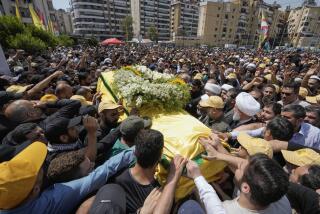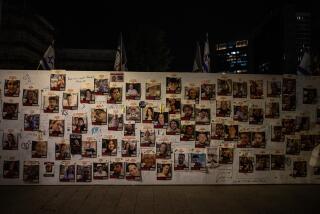The Team That Picks the Targets
- Share via
RIYADH, Saudi Arabia — In a squat aluminum building deep in the desert, U.S. Air Force Col. Doug Erlenbusch oversees a team of men and women who recommend the targets to be bombed in Baghdad, more than 650 miles away.
Erlenbusch and his crew at the $45-million Combined Air Operations Center weigh which houses and office buildings in the Iraqi capital belonging to Saddam Hussein’s leadership will be turned to rubble and, consequently, who lives and who dies.
The staff of the 28,400-square-foot air combat nerve center is guided by artificial eyes: more than 3,000 computers, bristling nests of antennas, walls of huge video screens, satellite links and 128,000 feet of high-speed-data cable.
Most of the thousands of pounds of munitions that have fallen on Baghdad since Thursday have hit their targets.
But Pentagon officials warn that even the highest-tech targeting, in a war that already has involved more than 6,000 combat missions, will occasionally go wrong -- and the wrong people will die.
“Sooner or later, it’s close to inevitable you’re going to hit something with serious collateral damage when you drop this many guided weapons,” said Franklin C. “Chuck” Spinney, a tactical air analyst at the Pentagon.
Iraq says at least three civilians have been killed and hundreds injured in the airstrikes on Baghdad.
Commanders of the U.S.-led forces face a daunting challenge in targeting Baghdad, a city of nearly 5 million people.
They seek to inflict enough damage to compel the most entrenched Iraqi forces to surrender while avoiding civilian casualties, which would inflame antiwar sentiment at home and anti-Americanism abroad.
Erlenbusch says the media images of the bombing of Baghdad in the opening hours of the air war provided the world with barely a hint of the size of the attack. “You have no idea of the vastness of that attack,” he said. “Looking out of the window of a hotel is like looking through a soda straw.”
The targets hit in the opening days of the war have been in Pentagon planners’ sights for years. Since the conclusion of the 1991 Gulf War, Iraq has remained a potential theater of operations for U.S. military planners, and specific bombing sites have been identified, analyzed, measured and mapped.
“We already knew where the Iraqi military headquarters were. It wasn’t a pull-it-out-of-the-seat-of-your-pants thing,” said Erlenbusch, a 1979 graduate of Cal State Fullerton and a former fighter pilot who commands the 609th Combat Plan Squadron.
Erlenbusch reports to Lt. Gen. T. Michael Moseley, commander of U.S. Central Command Air Forces, who is running the air war from his “battle cab” on the second floor of the air operations center. From their perch, senior officers look out a glass window to the hubbub and flashing electronic screens of the operations floor below.
Erlenbusch and his Guidance Apportionment and Targeting Team arrived at the air operations center in February with a full set of potential targets that they then had to analyze: Were they still legitimate targets? How close were they to civilian structures? What was the minimum level of explosive necessary to destroy them? Could the U.S.-led forces afford to cripple them, rather than destroy them? How would the necessary tankers, airlift, transport and support planes be factored into the battle plan on a minute-by-minute basis?
“The humanitarian piece, the collateral damage piece, I think it would probably blow the minds of a lot of folks to think how much time and effort goes into minimizing the weaponeering,” Erlenbusch said.
The team has worked seven days a week, 12 to 15 hours a day to refine targets, along with the weapons, aircraft and, in some cases, the flight paths necessary to take them out.
Air Force officials have declined to discuss their techniques to avoid schools, homes and hospitals that may be near intended targets, but one key aspect is a computer program. The process begins with precise coordinates of the proposed target -- beamed electronically to the air operations center from surveillance aircraft, unmanned aircraft, ground observers or other intelligence.
The program produces a “weaponeering solution,” which calculates the precise effects likely to occur on the target and surrounding properties, depending on what kind of explosive is used.
Navy Lt. Cmdr. Jeff Hubert said planners calculate the expected radius of the bomb blast and then make sure an area up to 10 times larger is clear of civilians. New technology also helps protect noncombatants.
“One of the primary things you need to remember, I was over here in ‘91, and the generation of weapons that has evolved since ’91 is a magnitude of accuracy higher,” said Navy Capt. Russ Penniman, who is Erlenbusch’s night-shift counterpart in combat planning.
To reduce problems in case the bomb falls long or short of the target, planners sometimes specify which angle bombers must use.
“That’s not to say there’s not going to be accidents, there’s not going to be a car driving by or a weapon that doesn’t guide, but those accidents are a part of war,” Erlenbusch said.
Once the target team comes up with a set of proposals, they go to another team to develop the master attack plan.
Starting with Moseley’s overall strategy for the day, the teams look at which aircraft are available and then develop a plan.
Sometimes, the best-laid plans have to be set aside for a sudden opportunity.
On the eve of the start of the air war, target planners got wind that Hussein might be at a presidential compound in Baghdad -- which forced the operations center team to rapidly process targeting information and assign aircraft.
“That was intelligence that gave us the ability to strike at that target. It was done in a matter of hours,” Erlenbusch said.
“Those first strikes were totally off the cuff. From the point where units were called who were in crew rest, ‘Get an airplane, do you have the planes loaded?’ ‘No, we don’t. Yeah, we do.’ ‘OK, brief it, fly it.’ And it happens. That quick. We’re talking hours.”
Unlike the 1991 Gulf War, when only about 10% of the weapons used were precision-guided, on the first night in Baghdad only precision-guided munitions were used, an Air Force spokesman said. Overall, the weapons make up more than 90% of the munitions dropped in the war.
Current and former defense officials say that as the air campaign in Baghdad and elsewhere proceeds, and the target list widens, the probability of one or more devastating misfires will rise.
Some Pentagon officials said that though the precision-guided missiles are far more accurate than conventional bombs most of the time, when they malfunction they are prone to going farther off course.
The greatest danger, they say, is a mechanical or electrical failure or human mistake that sends the weapon far from its intended destination. Some defense analysts refer to these as “gross errors.”
In Afghanistan, for instance, a U.S. Special Forces air controller inadvertently gave his own hilltop coordinates in his global positioning unit in December 2001. As a result, a B-52 dropped a 2,000-pound satellite-guided bomb on his position, killing three Green Berets and 25 Afghan allies and wounding Hamid Karzai, who was named the country’s interim prime minister later that day.
Even when the right target is hit, the results can be catastrophic. During the 1991 Gulf War, the U.S. struck a building believed to be a military command and control bunker in Baghdad. The Iraqis were using it as a residential bomb shelter, and hundreds of civilians were killed.
In 1999, a U.S. pilot mistakenly bombed the Chinese Embassy in Belgrade based on a bad map. The intended target was the Yugoslav Federal Directorate of Supply and Procurement.
“The bottom line is this: You can never guarantee you’re not going to have civilian casualties,” said retired Air Force Gen. Charles A. Horner, who commanded the U.S. air campaign in the 1991 Gulf War.
“You never know who’s in the building. We do everything that’s within our power to mitigate unintentional damage and civilian casualties. But war is ugly and messy.”
Murphy reported from Riyadh, Saudi Arabia, and Miller from Washington.
More to Read
Sign up for Essential California
The most important California stories and recommendations in your inbox every morning.
You may occasionally receive promotional content from the Los Angeles Times.













